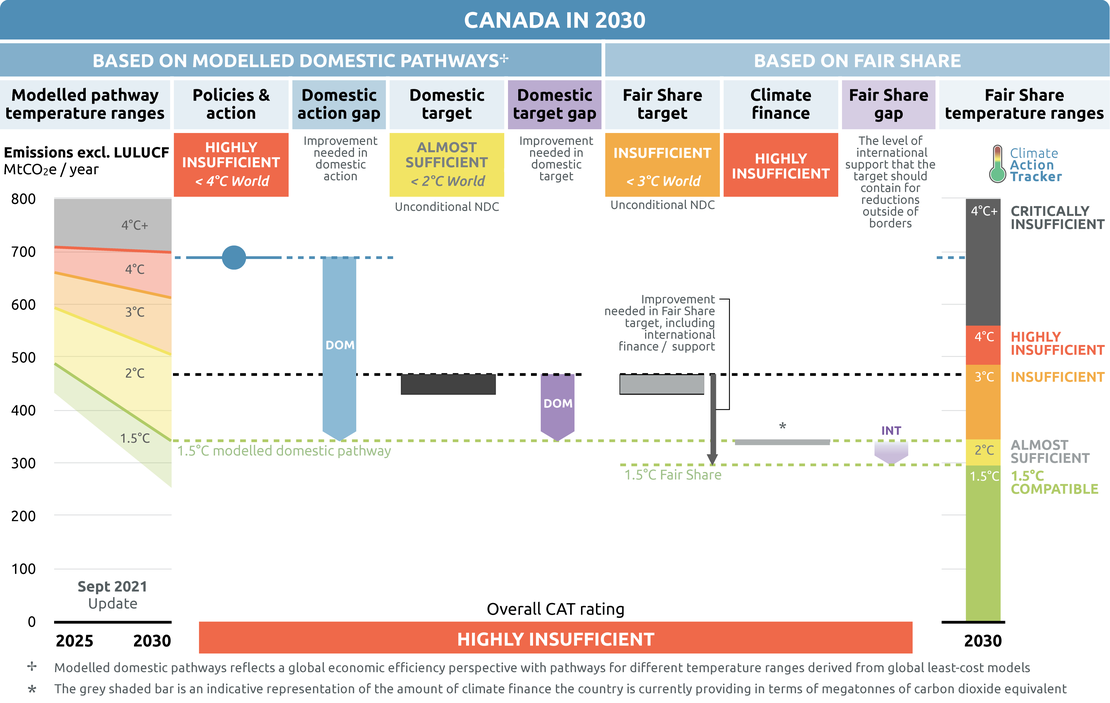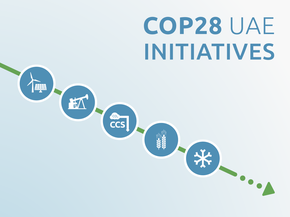Targets
Paris Agreement targets
NDC Overview
In July 2021, Canada submitted its updated NDC, where it strengthened its emission reduction target from a 30% reduction below 2005 levels by 2030 to at least 40-45% (Government of Canada, 2021d). The inclusion of the reference to ‘at least’ suggests that Canada may exceed this target. We calculate that this target equates to an emissions level in 2030 of 427-467 MtCO2e once the contribution from its land sector has been excluded.
The focus of Canada’s emissions reduction target is on cutting emissions domestically; however, in its NDC submission, Canada leaves the door open to supporting mitigation efforts abroad through the use of internationally transferred mitigation outcomes (ITMOs).
We rate targets against what a country should be doing within its own borders as well as what a fair contribution to limiting warming to 1.5°C would be. For the fair share target, we consider both its domestic reductions and any emissions it supports abroad through the use of market mechanisms or other ways of support. Further information on how the CAT rates countries (against modelled domestic pathways and fair share) can be found here.
As Canada has not defined international and domestic components of its NDC, we use the domestic target emissions level for both ratings.
The CAT rates Canada’s domestic target as “Almost sufficient” when compared to modelled domestic pathways and as “Insufficient” when compared to its fair share emissions allocation (“fair share target”).
The “Almost sufficient” rating indicates that Canada’s domestic target in 2030 is not yet consistent with limiting warming to 1.5°C but could be, with moderate improvements. If all countries were to follow Canada’s approach, warming could be held below—but not well below—2°C. In the graph above, the ‘domestic target gap’ shows the difference between where Canada’s updated NDC target is and where it would need to be to be 1.5°C compatible.
We rate Canada’s 2030 target as “Insufficient” when compared with its fair-share emissions allocation. The “Insufficient” rating indicates that Canada’s fair share target in 2030 needs substantial improvements to be consistent with limiting warming to 1.5°C. Canada’s target is at the least stringent end of what would be a fair share of global effort, and is not consistent with limiting warming to 1.5°C, unless other countries make much deeper reductions and comparably greater effort. If all countries were to follow Canada’s approach, warming would reach over 2°C and up to 3°C. To close the ‘fair share gap’ shown in the graph above, Canada either needs to begin supporting emission reductions abroad (on top of its domestic reductions, not as a means to reach its current NDC target level) or increase its provision of climate finance.
Canada’s international climate finance is rated “Highly insufficient” (see below) and is not enough to improve Canada’s fair share rating.

Canada’s international public climate finance contribution is rated “Highly insufficient.”
In June 2021, Canada announced a doubling of its climate finance commitment to CAD 5.3bn (USD 4.1bn) over the next five years (Government of Canada, 2021e). It will also increase the portion of funding in the form of grants from 30 to 40%. In 2015, Canada committed to CAD 2.65bn (USD 2.05bn) over five years. While the announced doubling is a positive development, its CAT climate finance rating is still ‘Highly insufficient’ as its contributions to date have been low compared to its fair share. The CAT weighs absolute contributions the highest amongst the four elements it assesses.
Canada remains committed to the collective goal of USD 100bn in climate finance for developing countries per year through 2025. However, the USD 100bn goal on its own is insufficient in the period post-2020.
Canada has a long way to go in phasing out support for fossil fuel development abroad. In 2020, its export credit agency provided over CAD 8bn (USD 6.2bn) in support of the oil and gas sector abroad (Export Development Canada, 2021b). While that number has been falling in recent years, it is still close to double what the agency provided in support of clean technology (CAD 4.55bn / USD 3.53bn). Overall, the agency provided CAD 19bn (USD 15bn) in support for carbon-intensive sectors in 2020.
In December 2018, the agency stopped providing financing for unabated coal-fired power plants and to companies that derive a significant portion of their revenue from thermal coal related activities (Export Development Canada, 2021a). This is not a complete ban on supporting thermal power abroad and the agency continues to provide some support to the coal sector (Export Development Canada, 2021b). As part of the G7, Canada has committed to end “new direct government support for unabated international thermal coal power generation by the end of 2021” (G7 United Kingdom, 2021).
To improve its rating, Canada needs to stop funding fossil fuel overseas and accelerate commitments to increase climate finance.
Net zero and other long-term target(s)
We evaluate the net zero target as: Average.
Canada passed the Canadian Net-Zero Emissions Accountability Act in June 2021 which enshrines its 2050 net zero target into law. The act also mandates the setting of intermediary targets at five-year intervals (2030, 20235, 2040, 2045) at least a decade in advance of each target, and the requirement to develop emissions reduction plans for these targets. The emissions reduction plan for the 2030 target, including an interim emissions reduction objective for 2026, is due by the end of 2021.
While Canada’s Net Zero Act has some positive measures, it does not follow good practice on a number of other aspects, such as including emissions from international aviation and shipping into its target, or providing any detail on how it will use the land sector or carbon dioxide removal as part of meeting its target.
For our full analysis of the net zero target, click here.
2020 pledge
Canada's Copenhagen pledge aimed to reduce emissions by 17% below 2005 levels by 2020. The Copenhagen pledge aligned Canada’s level of ambition to the United States, which also had a target of 17% reduction in emissions from 2005 levels by 2020. This target equates to a 14% reduction below 2005 levels, once the land sector is excluded.
Canada did not achieve its 2020 target, according to our estimate for emissions in that year, even with the effect of the pandemic. Canada’s target level was 638 MtCO2e (excluding the land sector contribution). We estimate its emissions were 651 MtCO2e in 2020.
Further analysis
Latest publications
Stay informed
Subscribe to our newsletter





